Thinking of making ‘The Way’ to Santiago de Compostela in Spain? Hundreds of thousands of people have made this spiritual journey over hundreds of years. Read on for some information, insights, and recommendations if you are considering embarking on this life-changing walk…
TIME TO GO
I walked the traditional and most popular route of Camino Frances in mid-April to mid-May 2012), mid-May to mid-June (2013), and October (2013). I also walked Camino Portuguese from Porto to Santiago in June (2015).
SPRING:
Don’t think that because you are going to Spain in the spring that the weather should be good or better than what you experience at home at the same time of year… it is one of those disappointing reminders that Spain is still pretty north in the northern hemisphere. And the Camino Frances is on nearly the same latitude as southern Ontario!
April: I DO NOT recommend it! The weather was very unpredictable and for about 75% of the walk we had rain and very strong winds. The temperature during that time was not great and some mornings we woke up to frost. There were days that I felt I could have worn a balaclava! Only the last three days were good and they weren’t just good, they were spectacular. We walked in shorts and t-shirts… finally! However, the weather that year all over Europe was apparently unseasonably cold so it is possible that April is normally a nice month. There are less people walking this time of year than in May-September though because it is spring, people believe that the weather will be good so there are still many. However, we never had a situation where we couldn’t find a place to sleep.
May into June was a beautiful time to walk because spring is well under way, the days are longer, the mornings brighter, and everywhere you can see and smell the beautiful new flora growing. There are trees bearing small garlic blossoms that you can actually eat… and they’re deliciously sweet! This time of year was when my mom and I walked together (for the first 10 days before she went home). It was pretty chilly to start as we had to forge our way through a blizzard the first day (May 15th!)

The next few days after were just as cold, like toque and mitten cold, but without the snow. However, after about 10 days the weather was finally warm enough to stop for a riverside break and put my feet in the water, which feels amazing after walking for several hours.
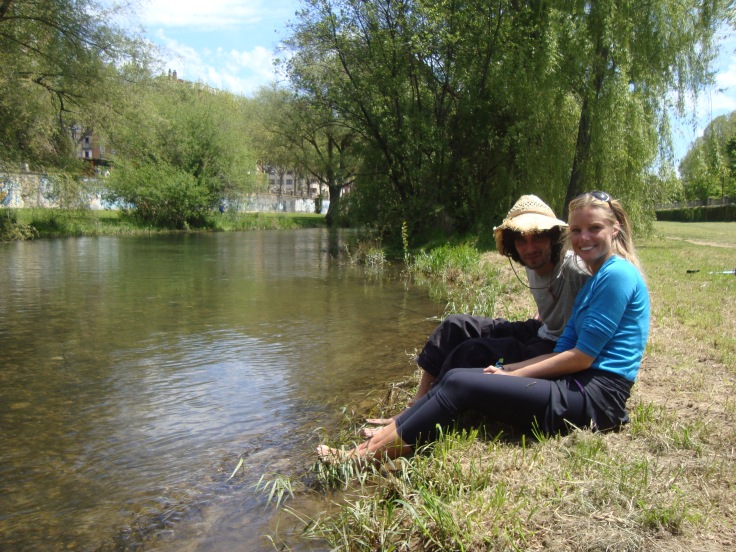
We had more warm, sunny days than cold, cloudy ones and there was not nearly as much rain as the year before in April, probably only about five or so days (not full days). I got a nice tan, natural highlights, and a beer almost every afternoon (of course this contributed to the current size of my ass but it was worth it). The one downfall to walking at this time of year is that many people are also walking, including university students having just finished their year (I don’t say this because I think it is a problem, only because it adds another population of people). The nice thing is that there is a lovely mix of ages and nationalities so you will always meet interesting people along the way. Because there are more people, there is a bit of race for some when it comes to finding a bed at the end of the day. Do your very best to not get caught up in this. We live in a fear-driven society and the Camino is no different (see section on the spirit of the Camino). Many people would rise at 5 am so that they could arrive at their chosen destination by noon just to ensure getting a bed and then spend the entire afternoon just sitting around. Many people even called ahead to reserve a bed. While that may be enjoyable for some I prefer spending the day walking and taking long, leisurely breaks. However, this meant that a few times I strolled into town and could not find an albergue that wasn’t “completo” (full). I usually just walked to the next town and found one although some people have told me that as a woman walking alone if you just say to the albergue owner that you are very tired (estoy muy cansada) and cannot continue (no puedes andar mas hoy) they will usually find a place for you, though it might mean sleeping on a mat on the floor (but even this arrangement is a one-up from true pilgrim style).
AUTUMN: The BEST!!!
October was my absolute favourite time for the weather. Whilst May was lovely for its new flora, I actually preferred early fall. The smell of decay in the air is lovely and earthy and sweet (maybe that sounds weird), unlike the fresh, sweet smell of spring. Maybe this seems irrelevant to mention but after many days walking outside all day long surrounded by nature one definitely becomes more in touch with it and its beauty, not only aesthetic beauty but also the beauty of different smells (there is less manure smell in the fall than in the spring, with the exception of the region of Galicia which always smells like manure), sounds, feels and tastes. All along the way through Rioja I sampled grapes off the vine (totally acceptable), picked and ate blackberries as I walked and helped my Spanish friend forage for mushrooms that we later cooked and ate for dinner. The weather was fantastic! I started warm and I finished warm. I walked 75% of the way in shorts. The sun shone all day for about 3 weeks and the temperature was between 20 and 28 most days (though towards the end of October there were a few rainy, cool days). Because the days are shorter I saw the sun rise every day and often walked into the sunset… it doesn’t get much better than that! This was the Camino that I spent the most time picnicking and napping riverside, and dunking my head under all the drinking fountains along the way. There are many less people walking this time of year so I had no issues having my pick of places to stay. October was the BEST (have a made a good case for it?) However, October that year (2013) was apparently unseasonably warm in Europe so if you’re thinking of going in the fall I would suggest starting mid-September and finishing mid-October, depending on how long you want to take to do it.
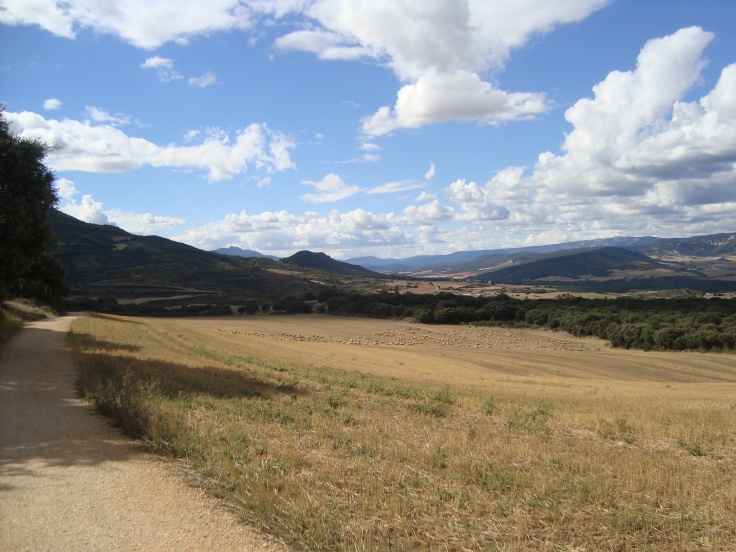 (Those are sheep in the distance dappling the wheat fields)
(Those are sheep in the distance dappling the wheat fields)
THE REGIONAL LANDSCAPES
Every time I make the way I have a new favourite region. The first time I loved Galicia. The second time I loved Navarra. The third time I loved Rioja and Castilla y Leon, where the meseta (flat lands) is. Along the way is the option to take alternative routes, which are usually marked. For the most part I preferred the alternative routes because they tend to veer away from the senda (road) when the principle route remains alongside the road.
Navarra
Navarra is gorgeous: rugged and hilly and green. This is your acquaintance with the Camino so it is extra special because of that. This part is also where you will first meet the people you will continue to see throughout the journey and perhaps even walk with for a period of time. This region is where you will find awesome chorizo (spicy sausage), great pinxos (similar to tapas), and Pamplona, which is where San Fermin (the running of the bulls) is in July. Pamplona is the first big-ish city you will encounter and it is lovely inside the massive wall. Depending on your walking speed you will likely spend about a week walking in Navarra.
The first day is the hardest. It is about 28 km, mostly uphill and the weather can be very unpredictable (hence walking in a blizzard in May!) But it definitely sets a benchmark that makes every day after it seem easy. It is easily one of the most beautiful days too for a couple reasons. One is because you are hiking through the Pyrenees, crossing from France into Spain and how can that not be beautiful? The second is because the experience is still new so you will be awestruck by everything. The first time I did that hike I cried over how beautiful the surroundings were. Hopefully you will have a clear day so you can enjoy what is a breathtaking view of the rolling hills and little villages tucked in the valleys.
My favourite part of Navarra is the days between Puente la Reina and Los Arcos. I particularly like Puente la Reina not only because it has sentimental value for me but because it has the most beautiful church and old bridge (puente). It has two churches but one is grander than the other. I prefer the smaller, more modest one. The second time I visited it there was no one there and so I sat and sang Amazing Grace (not because I’m religious but because I just like the sound of the song) and the echo was amazing; the entire structure is stone.
Leaving the town of Estella you will find the “fuente del vino” in Irache. Have a cup handy because you can fill it with free red wine from the fountain. The only time I was there that it hadn’t already run dry was in October and I enjoyed a full cup in the early afternoon under the sun ☺
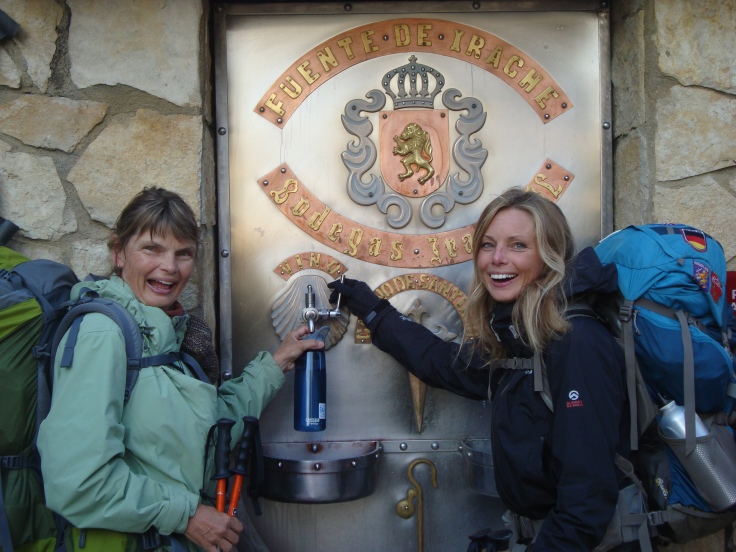
La Rioja
This is the famous wine region and here (as in the rest of Spain) you will find a bottle of Rioja for as little as two Euros. In Canada, a low-end bottle of Rioja costs about $20. Of course there are more expensive Riojas but one of my favourite is Campo Viejo.
The biggest city in La Rioja is Logrono (the n should have a tilde ~ to make it sound Logronyo) but otherwise it is a fairly small region compared to others (should only take about three or so days to walk). Towards the end of this region the terrain starts to flatten out a bit towards Santo Domingo. In May all around were fields of these pretty yellow flowers and red tulips and wide open space… just gorgeous.

Santo Domingo is a pretty town with one of the nicest municipal albergues. There is a legend associated with this town that I can’t remember but there is one for many towns. Many of the guide books tell the stories.
Castilla y Leon
Home of the meseta and the most delicious soup… if you like loads of garlic! It is unremarkably named “sopa de ajo” – garlic soup. Castilla y Leon is the largest area on the Camino and is comprised of the smaller regions of Burgos (a big city), Palencia, and Leon (also a big city). For many people, Castilla y Leon, between Burgos and Leon, is many people’s least favourite part of the Camino because it is very flat (la meseta). Much of the walk between these two cities is along the road unless you take the alternative routes, which I highly recommend. But the parts that are not along the road are lovely because you can see for miles. In the fall there are “fields of gold” wheat, fields of dying/dead sunflowers from which people have picked the seeds to create faces on the flowers (and you can eat the seeds – fall is an edible season!), and massive hay stacks. In the spring it is fresh grass, flowers, and manure. There is little shade along the meseta and the water fountains are often dry (there are many fresh water fountains all along the Camino) so be prepared with extra water and a sun hat should the weather be warm and sunny.

A few days before reaching Burgos you will come to a very small town (it is more a speed bump) called Tosantos. If you can, stay here at the parroquial where they do a massive group dinner (by donation and everyone helps) and a group prayer. Burgos is a great spot to pick up anything you might need (that you didn’t get or couldn’t find in Pamplona). There are lots of shops, farmacias, and bars/restaurants. There is another good municipal albergue here but many people choose to have a hotel night in Burgos to get a hot bath and a private sleep. If you are so inclined to splurge on a hotel I suggest waiting until Leon where the municipal albergue is really tight and dirty and the curfew is 9 pm. I stayed at a hotel one time called La Petit Leon, right in the centre, great value. The cathedral in Leon is spectacular but you have to pay to get in. Burgos also has a pretty spectacular cathedral and I don’t believe there is an entry cost.
Shortly after Castrojeriz, the massive kilometer-long ascent, and then the long stretch of amazing wide open space, you will reach Ermita de San Nicolas. Stay at the albergue here if you can (another humble church run by Italians who put on a big dinner by donation). A little further along (a day or two) is Carrion de Los Condes. There are lots of albergues but I recommend one in particular if you like singing groups and you want a taste of the religious side of the Camino (see section on albergues). Leaving Carrion de los Condes you will walk for 17 km down one straight path. There are no bars, no water, and only two rest areas with benches. If the weather is bad or very hot you want to be well prepared with sufficient water and snacks because you may have to walk the whole 17 km without rest (I had to the very first time because the wind was about 70 km per hour and if I stopped I would have froze. The second time I ran out of water and had killer blisters. Third time was a charm first thing in the morning watching the sun rise the whole way ☺)
The long walk into Leon can be painful because much of it is close to the road and once you have hit city you still have a long way to go. Many people take the bus for the last 5-7 km. I have never done that and I don’t recommend it. It is like skipping over the parts of your life that aren’t as pleasant just to get to the good stuff, you miss out on some important learning.
Just before you get to Astorga you are going to cross a road via a maddening green switchback bridge. It will take you 5 minutes just to cross the road! It’s really funny actually. Astorga is the next big town after Leon and it is a pretty little town famous for its chocolate so stock up! There is a chocolate museum here too. Also in Astorga is the Palacio Episcopal, Gaudi architecture. Though not as grand as the Sagrada Familia it is similar to what you see in Barcelona.
From Astorga the terrain starts to become more rugged again. Shortly after you leave Foncebadon, you will arrive at Cruz de Ferro (see the section on spirituality for its significance). Villafranca del Bierzo is my favourite town in this part. It is really pretty and the cobblestone streets make it so quaint, if not terribly difficult to walk on in flip flops! Leaving Villafranca you can take one of three routes. The most challenging route (Dragonte) is by far the most spectacular though difficult to follow for the signage is poor. Try though because you will feel like you are on a camino from the Camino. And the views are spec-tac-u-lar!
Galicia
Just before reaching O’Cebreiro you will pass into the region of Galicia, most people’s favourite part of the Camino and the region that hosts Santiago de Compostela and the most delicious regional specialty: pulpo (octopus). Its climate is similar to the west coast of Canada: fresh, very green, and lots of rain (though I didn’t find any more rain fell than in other parts but the air is definitely damper). O’Cebreiro is lovely and small and has Celtic roots. About a day and a bit past O’Cebreiro, a few kilometres past Triacastela you will reach the speedbump town of A Balsa. Stay at the wonderful little albergue here if you can owned by the Dutch/Italian couple who met and fell in love on the Camino.
The next big town is Sarria and now you are only 100 km from Santiago… you and everyone else. Many, many people begin the Camino in Sarria because you only need to show that you have walked 100 km to get your Compostela (certificate) so the path gets a little busier after this and you start seeing people with flashy, new-looking gear. This is when you begin to realise how far you’ve actually come. Feel free to call yourself a Camino veteran at this point.
The next part of Galicia with real significance for me is Santiago de Compostela of course. You will be kind of dazed walking into the city towards the massive Plaza de Obradoiro (Praza do Obradoiro in Catalan). Plunk yourself down in the plaza alongside other pilgrims and stare up at the gorgeous cathedral. Take a few minutes to reflect on how far you’ve come… it can be a fairly emotional experience. Attend the 12 noon pilgrim’s mass that is on everyday (there is one later in the day too) and watch the massive botafumerio swing clear across the interior of the cathedral. You can also take a peek at where St. James’ remains are said to be. Wander around Santiago and reunite with people you connected with in Navarra but haven’t seen since. Just feel the place… it is a beautiful city. Then go to the pilgrim’s office with your pilgrim’s passport and collect your Compostela and handy tube to transport it in. Then celebrate at El Gato Negro with copious amounts of vino and fresh seafood. It’s a popular place so get there before you are hungry! If you want to stay at a nice hotel here but can’t justify $400 a night for the Parador (the original pilgrim’s hostel) then stay at Hotel Rua Villar right across the street from the pilgrim’s office. It’s in a great location especially if you get a street view.

THE ALBERGUES (HOSTELS), TIENDAS AND RESTAURANTS/BARS
ALBERGUES
In nearly every town is at least one (but usually more) albergue, which is the Spanish word for a pilgrim’s hostel. Most albergues can host about 10 people though many of them have many more beds. Most of the time you will find bunk beds and anywhere between 10-60 beds in one dormitory… you can imagine the smell in the larger dorms once people are all settled in for the night. Most albergues request that you leave your hiking boots outside the dorm though to limit the dorm smell to only body odor and gas ☺. Snoring can be a bit of a problem which is why ear plugs are necessary for some people who are light sleepers. Many albergues have blankets though most people carry a sleeping bag and/or liner. Some of the albergues are new and “state of the art”, very clean with fully equipped kitchens, hot showers, loads space between bunk beds, wifi, and washing and drying machines, whilst others are not well cared for. Where you choose to stay depends on what is important to you. For some, cleanliness is top of the list. Personally, the really clean ones border a bit on clinical for me and lack the character that makes the Camino so special. For others, character is most important and these are the people who choose to stay in the parroquials or private albergues that have something special on offer, such as a group dinner by donation, a meditation session, etc. Personally these are the places that I like to stay which sometimes means sacrificing a hot, clean shower or something like that. You’ll realise after a while (hopefully) that hygiene and vanity are less important than spirituality or social connections. I have provided a breakdown on the different types of albergues below.
Municipal albergues
In each moderate sized town you will find a municipal albergue, which is government supported. They are standardised facilities and cost between 5 and 7 Euros, though some are strictly by donation. They tend to be bigger, hosting more beds, and located in the centre of town. In most municipals you will have access to the kitchen facilities. Some are great and others are seriously lacking. In Galicia where many of the municipal albergues are new you will find very nice kitchens but oftentimes no dishes. The great thing about staying at the municipal albergues is that you feed into the Spanish government’s support of Camino tourism, which is a good thing. Also, they tend to be lower priced than the private albergues so you will find a somewhat different class of pilgrim here (in my experience, a slightly more “authentic” pilgrim, and I mean that in the most non-judgemental way). Also because of this there tends to be a greater diversity of people so you will be exposed to some very interesting people, which can make for a fun social experience in the evenings.
Private albergues
These albergues are private businesses usually run by native Spaniards, though sometimes you will find people from other European countries. They are usually more expensive but if you want a bit more space, cleanliness and extras you can usually bank on these ones for that but not always.
Parroquials/Monasteries/Hospitaleros
In my opinion these are the best places to stay. There is often no fixed cost and thus they accept donations. They show you a bit of the religious/spiritual side too with activities like a pilgrim’s mass, group prayer, donation dinners, and singing. For me, these places house the real spirit of the Camino more than other albergues. Because they operate off donations they have less comforts than the other albergues but again, where you choose to stay depends on the kind of experience you are looking for.
There are also hotels and “casas rurales” along the way which can offer a nice reprieve at the end of a long hard day.
THE TIENDAS AND ALIMENTACIONES
These are little shops you will find in many towns along the way. Here you can buy fruits, veggies, bread, frutos secos (nuts/trail mix) and other food items.
RESTAURANTS/BARS
There are many along the way. Sometimes when there is nothing else in town you can still find a bar. And a bar in Spain isn’t like a bar in North America. It is more like a cafe where you can get a glass of wine or beer. Most bars serve food as well, such as bocadillos: sandwiches on baguette filled with chorizo (sausage), jamon (prosciutto), queso (cheese), verduras (vegetables, though these often come with tuna), and tortilla de patata (the ubiquitous thick egg and onion omelet thing… delicious). Many restaurants and bars along the way also offer a “menu del dia” (menu of the day). For the most part they are fairly disappointing and end up being way too much food anyway. The only good thing about them is that they usually include unlimited wine ☺ and pan (bread). I usually buy my food at an alimentacion and make something at the albergue. You’ll find after a few days in as people start getting to know each other that groups will make and eat dinners together, which is a lovely experience.
LOS PEREGINOS Y PERSONAS (THE PILGRIMS AND PEOPLE)
People from all over the world are represented on the Camino, though you don’t find many people from the Middle East, South-East Asia, or Africa. There are lots of Europeans obviously, many of whom walk short segments of the Camino every year. There is also a range of ages from children up to 80 years old! Meeting people on the Camino is easy, particularly because virtually everyone offers each other the greeting “buen camino” along the way. Whilst silence and solitude can be golden, the friendships that develop along the way can be one of the most beautiful aspects of the Camino experience. On a journey as long, arduous, and spiritual as the Camino, finding support in other people is important. Where at home in regular life, interactions with complete strangers seldom occur for non-practical purposes, along the Camino they are the norm, particularly if you walk on your own. Once I learned to stop complaining about my fatigue, aches and pains and I opened myself up to the experience I made many connections to other people and got back the positivity I put out.
In my experience the native Spanish people (the ones living and working in the towns along the way, not the pilgrims) are not always the friendliest bunch of people. Whilst this may have something to do with the commercial boom that has occurred on the Camino Frances over the past decade I think it is more a cultural trait than anything else. Perhaps I notice it because the attitude of the people is in such contrast to friendly Canadians. Spaniards don’t usually go out of their way for you (I realise this sounds like a sweeping generalisation but I am speaking from my experience). You may sit for hours in a bar without being asked if you want another drink, the bill, or anything else. On the bright side, this makes for more authentic interactions: if someone doesn’t like you they won’t pretend to. Just try to speak a bit of the language and express your appreciation. You can get by fairly well only speaking English but there might be a few times that you will need Spanish should you want to get beyond the usual pleasantries. This will prove difficult as not as many people in Spain speak English as in other European countries (in my experience). And proper pronunciation in Spanish is key for understanding. You can say a word until you’re blue in the face and you won’t be understood if your ‘a’ sounds slightly off.
WHAT TO BRING
This is probably the thing people struggle with the most. Don’t worry. If you bring too much you can ship it to Santiago to be picked up when you arrive, and at a very low cost special for pilgrims. Even the third time I walked the Camino I still brought too much but I was also prepared for cold weather which we didn’t have so I sent a few things on, including my sleeping bag! I have made a list below:
Essentials
- A waterproof rain jacket (Gortex is best)
- Waterproof boots (however some people advise wearing running shoes. I personally like hiking boots because they provide ankle support. Waterproof ones do tend to get a bit hot on warm days but it beats having cold, wet feet on rainy days! And you can always soak your feet in the river if they get too warm or walk barefoot a little ways).
- A proper fitting backpack. You should try putting weights into different packs so you can walk around and try them out. A 30-35 litre pack should be large enough.
- Vaseline or greasy cream for your feet. Put this on your feet every morning before putting on your socks. Likewise, if you do a foot soak in the river during the day, reapply. This cream prevents friction that causes blisters, usually the number one reason people have to stop walking.
- About 3 pairs of good socks. Some people swear by wearing two pairs, the thin inner pair acting as a liner. Personally I have found that applying the cream and wearing one good pair of merino wool socks is better than doubling up. You can find good merino wool socks at most outdoor clothing/hiking shops and they are worth every penny. I have been rotating my three pairs for two years and I only just discovered a hole in one pair now (that’s after three Caminos and long trek in the Himalayas)
- Pyjamas. This really just depends on what you like to wear to bed but when I am travelling I like to have long pants and a t-shirt. You will see some men walking around albergues in their briefs, which can be pleasant or unpleasant.
- Silk sleep liner. This can act as a sleeping bag should you choose not to bring one. Silk is good because it is lightweight and feels heavenly at the end of the day.
- Rain cover for your pack. Before you buy it stuff the backpack full of stuff and then try the rain cover on. It is no good to you if it’s too small!
- Pack towel. You can get one a quick dry one at MEC.
- A head torch for early mornings and walking in the dark.

I took this picture before I discovered the awesome foot cream that saved me on subsequent walks.
Clothing
- I usually pack two walking “outfits”: a cold weather one and a hot weather one:
- For the cold weather:
- Long stretch pants. I like running pants that are fitted all the way down to the ankle to avoid the swish swish that occurs at the ankles with baggy pants. They also avoid chaffing that can occur on the inner thigh when nylon hiking pants are worn. Some people like the hiking pants that convert into shorts. I personally find these a pain in the ass because compared to stretch pants they are nowhere near as comfortable and because when I do want to remove the lower leg whilst they’re on I have to take my boots off.
- Long-sleeved shirt. Cotton is okay but stays damp longer than other materials. A proper wicking shirt is good or a snug-fitting merino wool shirt. The great thing about merino wool is that if you remove it, turn in inside out, and air it out at the end of the day you can wear it multiple times without washing it (same with the socks though I have a three day limit).
- A long-sleeved hooded sweater to wear over the other for added warmth. Choose something thin and lightweight in case you end up not needing to wear it often.
- A scarf or neck warmer thing (like a tube)
- A toque (winter hat)
- Gloves
- For the warm weather:
- Shorts or short pants. Athletic like. I personally like running shorts with built in underwear because I can just wear a new thin panty liner everyday and not have to worry about washing the shorts every day. This may sound gross to some people but it is one of the tricks of the travelling trade I discovered from the many adventurous women I’ve met ☺
- Tank top. The same considerations as in warm weather clothing apply here.
- T-shirt. The same considerations as in warm weather clothing apply here.
Other things
- Ear plugs just in case snoring bothers you.
- A small flashlight. Extra batteries aren’t really necessary because there are many shops along the way where you can pick up these types of things as you need them.
- A modest first aid kit. Very small. A lot is not necessary because you will find a farmacia in nearly every town.
- Sunscreen.
- Sunhat.
- Sunglasses for those long sunny days of little shade on the meseta.
- Guidebook (I recommend A Pilgrim’s Guide to the Camino de Santiago by John Brierley. I recommend a guide book only so you don’t miss out on some of the historical monuments and the like and a little information about them. Try hard not to use it to plan ahead too much as having a mapped out itinerary can detract from the freedom and spontaneity you will surely feel. Remember you are free, you don’t have to consult your day timer.
- Your toiletries… the bare necessities. Everything adds weight that you will carry for 800 km.
- A journal or small book for writing down your thoughts and experiences. It is a personal choice of course but I believe documenting these special experiences in life is important for reflection.
- A pocket knife, spoon, and corkscrew for your riverside picnics ☺
- A little refillable bottle of soap. It is rare to find soap in the washrooms along the Camino.
- Tissue packets. Just a couple as you can buy these along the way. They will often act as your toilet paper so keep them in a place that is always accessible.
- A money belt or pouch where you can store your cash and passport and other important things (such as your pilgrim’s passport)
Considerations - Some people swear by gators, the nylon legwarmer-looking things that cover the bottom of your pants to protect your pants from getting muddy or rain getting into your boots through the top. Out of three times walking I can think of only once that I would have appreciated a pair.
- Sleeping bag. If you choose to bring one a lightweight one is best. Most albergues have blankets and thus you can usually get by with a liner.
- Walking poles/sticks. You can pick these up in St. Jean Pied du Port if you so wish. I didn’t use them the first time but did the second, third, and fourth times. I used two walking poles that I got for 20 Euros each in St. Jean. I liked using them because they provided stability if I was walking on a muddy hill or in strong wind. I used them to help me up a nasty hill when I was particularly tired. I also found that they involved my arms in the exercise more and so that they even toned up a little.
- Camelback fancy water system thing. Some people love these. I think they’re a pain in the ass. I much prefer a refillable water bottle stored in a spot that I can reach with little effort whilst I walk.
- Poncho. You can buy a proper one for a lot of money or you can pick one up along the way if the weather is really terrible. I don’t think they’re overly necessary though I did buy a cheap one on my first two Caminos that I wore for a few days. They’re really sexy so be prepared for lots of attention.

NOTE: If you like “proper” clothing for specific occasions you may choose to buy proper athletic/trekking clothing. There are a few quality items that I like (socks and good running pants) but for the most part I just wore my old clothes I didn’t really care about. I still have a $10 Old Navy tank top that I wore for all three Caminos and my trek in Nepal… now I just keep it out of sentimental value. You could spend a ton of money on the proper things and may be more comfortable in the long run but I think you’ll find once you get going that in general, we always think we need more and better stuff than we actually do.
DURATION
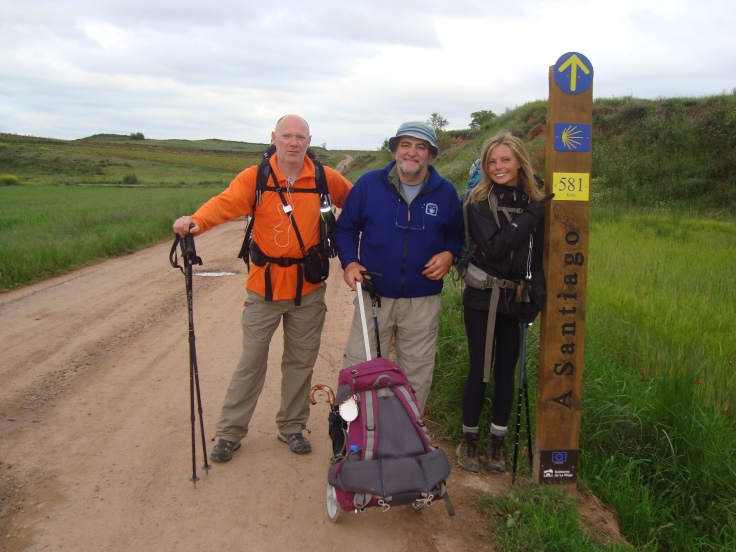
This picture was taken well into the walk. The total distance from Saint Jean is roughly 800 km
How long you take to walk depends on a few things: the weather, any injuries that occur, people you meet, your comfortable pace. Most people take about a month to do it, give or take a few days. That means walking an average of 25 km per day. Maybe that sounds a lot but once you get into the rhythm and have a couple of long days (my longest was 46 km) you find that a 20 km day is nothing. It is easy to start off with a lot of pep and think that will continue the whole time. Pace yourself. While I think pushing the envelope a bit is a good thing, don’t do this right at the beginning or you could end up with an injury. Most people who injure themselves do so in the first 10 days. Take your time, enjoy the scenery, take lots of breaks. It will be over before you know it so aprovechar su tiempo y libertad! (Take advantage or your time and freedom).
You may choose to walk to Fisterre or Muxia from Santiago, which will tack on an extra 3 days. It is a lovely walk with many less people and amenities along the way. And there is something special and somewhat more final about finishing at the ocean: you can’t actually walk any further west. I have never been to Muxia but I have been to Fisterre twice.
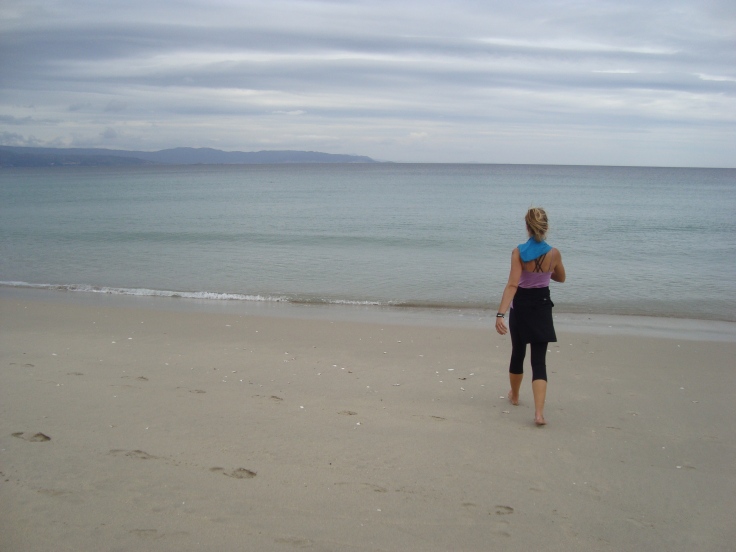
BUDGET
Depending on how you do it, plan to spend about 20 Euros a day. This should be more than enough if you consider that the average cost of a municipal albergue is five Euros a night. That leaves you with 15 Euros a day for food. If you are doing menus del dias and multiple coffees and beers a day then that is not enough. But if you use the supermarkets and albergue kitchens it’s enough. Have a little extra on budget for any little souvenirs you might want to buy, such as postcards, a bracelet, rosary, etc.
THE SPIRITUAL AND PERSONAL CHALLENGES
This is probably the most important aspect of the Camino. At the end of the day it doesn’t matter where or what you ate, if you have 20 blisters, not enough or too much clothing, what jerks you’ve met along the way, where you slept, or if you’ve gotten bed bugs. Nothing is perfect and even better, nothing is permanent. Don’t be afraid of not being properly prepared, taking risks, doing something different, walking alone, walking with another person or people, singing as you walk, swinging on a swing, stopping and doing a cartwheel just because it feels good (my personal favourite is the laughing, dying cockroach – see my video on this site). Basically, don’t be afraid to let go of worry and fear; they can be heavier than all the things in your backpack combined. The experience comprises the good, bad, hot, cold, frustrating, angry, spectacular, painful, uncomfortable, ugly, beautiful and humbling reality of life. It is like life in a nutshell; life reduced to 30 days. How far you go both physically and spiritually is up to you. If you let it, it will make you stronger.
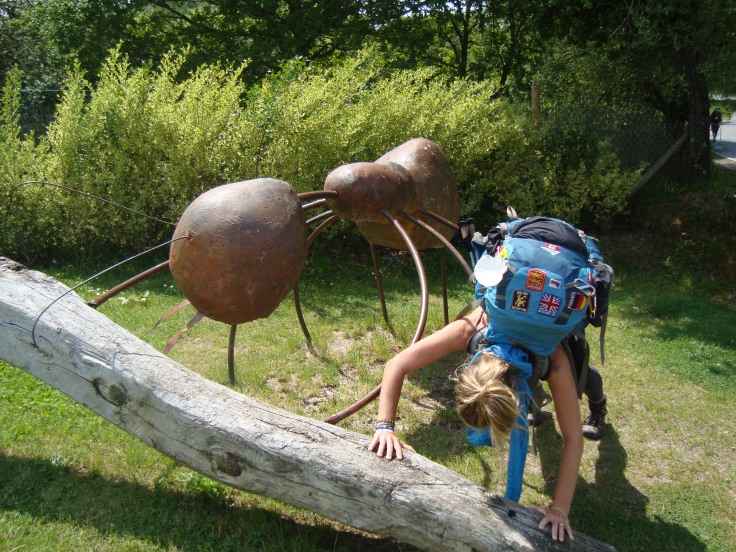
On my first Camino when I was having a particularly terrible day I went for a walk and eventually ended up in a bar with a copa de vino tinto (glass of red wine) writing in my journal. I met a man who told me that the Camino provides three tests. The first test is physical. Think of this phase as birth to young adulthood. Your body is not used to walking all day every day and so you will feel the pain everywhere for the first few days. It’s normal. Your attitude, the novelty of the experience, and the beauty of the surroundings are what keep you going. The second test is mental. Think of this phase as young and middle adulthood. Your body is finally on board with what you have demanded of it and you begin to get into a rhythm. The landscape begins to flatten as you approach the meseta and the beauty of the surroundings is not as apparent as it was at the beginning. You may have developed an irritating blister or the like. You feel a bit like you’re trudging through something that started out so great though doesn’t seem as spectacular as it did at the beginning. You start listening to music or hurrying your pace just to distract yourself or get on with it. Your attitude, commitment to yourself, and perseverance are what help you through this stage. The third test is spiritual. Think of the stage as middle to older adulthood where you begin to realise the impermanence of things, you begin to accept what is out of your control and understand yourself and others better. You have made it through some challenges, both inner and outer, and are drawing close to Santiago.
During this third phrase you reach Cruz de Ferro where you can release all the burdens, grief, anger, and pain that you have been carrying with you (many people represent their burdens with a rock which they leave behind on the giant pile). You realise the end is coming soon and rather than focusing on the fact that a beautiful experience is ending you realise that it will always be with you and you vow to bring that spirit back home with you into your regular life. This stage is like a culmination of what you experienced in the first two stages. If you complained every day, got easily irritated with yourself and others, and allowed the little monsters called commercialism, vanity, competition, superficiality and negativity suck you in then you will likely feel like you are missing something during this third phase of the Camino. I have had people say to me on the last day “oh I couldn’t take any more rain, I am glad this is over”. I felt sorry for these people because they let things like weather or other people’s bad attitudes affect their own attitude and thus their experience. My most important words of advice come from Mother Theresa: “Let no one ever come to you without feeling happier and better”. In offering a smile and kind words to every person you encounter you can spread positive energy and trust me, that can make for an entirely different experience, regardless of circumstances.
I took the following from a blog I wrote about a month after I had finished my first Camino:
“So this is the thing about the Camino: it ends but it never really ends. In a sense it is symbolic of life and all its phases and tumult. The first part of life is truly physical. So much development is taking place as one begins to adapt to her environment. We learn to walk the walk (no pun intended) and talk the talk. On the Camino, relationships develop in that first week too… a social context forms. Then with the development of higher-order and abstract thinking, we begin a mental journey where we recognise the real truth of the phrase “ignorance is bliss”. The spiritual phase occurs when we (hopefully) learn from our past mistakes and all the tests life offers and achieve a certain wisdom about life, an understanding about life that comes only with experience.”
For me, this is the true experience of the Camino. It is not about how far I walked, whether I had the right gear, if I drank too much wine or ate too much chocolate (or maybe not enough for that matter), or whether the weather was shitty or spectacular. It is about what I learned along the way and the relationships I formed.
Contact me if you have any questions. Enjoy every minute and…
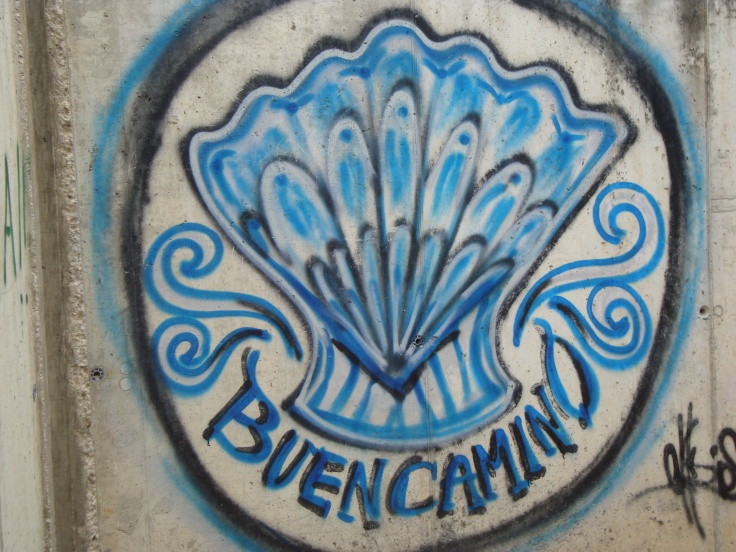
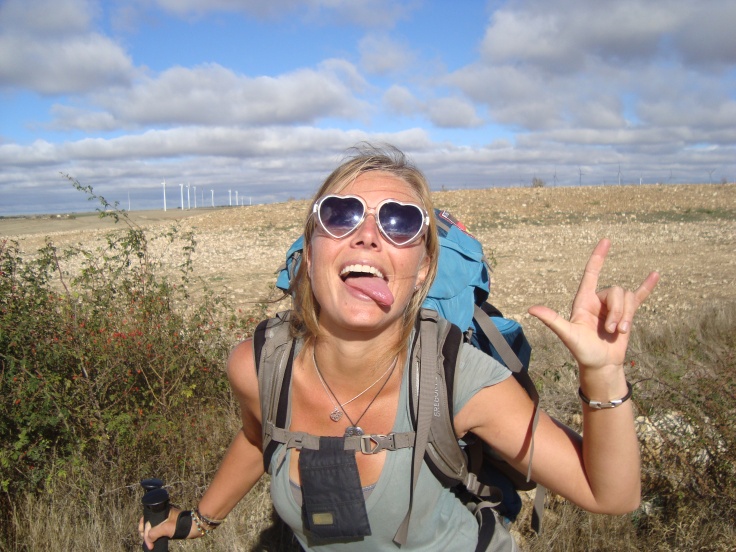
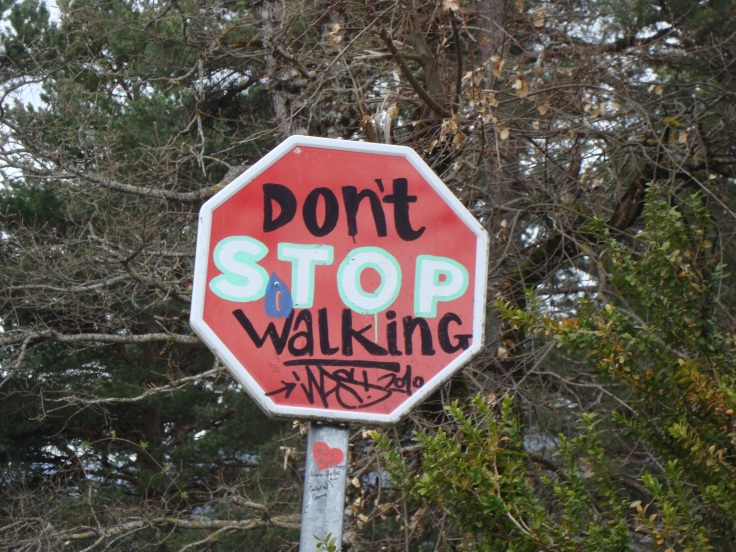

Great article Colleen:) I feel lucky to have traveled with the best!
Xx
LikeLike
This is amazing. I leave for my camino in 18 days. I have been having doubts/fears but I am guessing that is normal considering I am going alone as a woman. Reading your blog made me so much more confident and positive. Thank you for sharing
LikeLike
This is totally normal. I was so scared the first time I went on my own and I’d already done it once! It is an amazing experience… changed my life. Be open to all it offers, even that difficult stuff. Thanks for checking out my blog and for commenting. Feel free to share it. Buen Camino 🙂
LikeLike